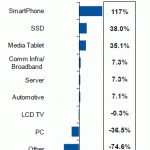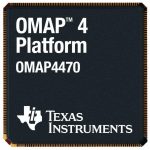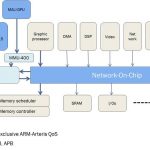Network on Chip (NoC) technology is probably one of the most fascinating new concepts that has been developed and is implemented in real chips. NoC can be integrated into various System on Chip (SOC), targeting several market segment: Video Processing, Consumer Electronics, Automotive, Networking, Multimedia (digital TV),… Read More
Tag: arteris
So British! with Mike MULLER (ARM CTO & Founder) at SAME Conference
SAME conference has started with Joel Huloux, Chairman of the MIPI Alliance, who gave a high level introduction about MIPI, rather business than technology oriented, talking to Marketing/Management audience. Extracting the main points from his presentation:
- More than 30 specifications have been issued (Important remark:
Virtual Prototype your SoC including Arteris FlexNoC and optimize architecture using CPAK from Carbon
I have talked about Virtual Prototyping a SoC including FlexNoC Network on Chip IP from Arteris by using Carbon Design Systems set of tools in a previous post. A blog, posted on Carbon’ web, is clearly explaining the process to follow to optimize a fabric (FlexNoC) successively using the different tools from Carbon. Bill Neifert,… Read More
Arteris joins Inc. 500 List of America’s Fastest-Growing Private Companies… thanks to Arteris customers!
Arteris, founded in 2003, is the inventor and leading supplier of network-on-chip (NoC) interconnect IP solutions. Can we say that the company is still a start-up? I would say yes, as their flagship product, FlexNoc (Network on Chip IP function) was a completely new concept when it was introduced. As for every disruptive technology,… Read More
Arteris FlexNoC penetration increase… everywhere
The need for Network-on-Chip (NoC) has appeared at the time where chip makers realized that they could really integrate a complete system on a single die to build a System-on-Chip (SoC). At the early times (1995-2005), the so-call NoC IP suppliers were in fact proposing a crossbar switch, a pretty old concept initially developed… Read More
Webinar: how to reduce mobile device cost and board space with LLI
LLI Specification has been officially released by the MIPI Alliance, at the occasion of the Mobile World Congress in Barcelona, this year. As indicated by the name, the round-trip latency of the LLI inter-chip connection is fast enough for a mobile phone modem to share an application processor’s memory while maintaining… Read More
Network on Chip in Automotive: Arteris
The recent announcement from Arteris that iC-Logic chose FlexNoC and C2C to create a flexible and high speed communication chip to respond to the increasing demand of high speed connectivity in car infotainment systems is very interesting, as it shows that SoC designed for the Automotive market segment also require advanced … Read More
Smart mobile SoCs: Texas Instruments
TI has parlayed its heritage in digital signal processing and long-term relationships with mobile device makers into a leadership position in mobile SoCs. They boast a relatively huge portfolio of design wins thanks to being the launch platform for Android 4.0. On the horizon, the next generation OMAP 5 could change the entire… Read More
Arteris evangelization High Speed Interfaces!
Kurt Shuler from Arteris has written a short but useful blog about the various high speed interface protocols currently used in the wireless handset (and smartphone) IP ecosystem. Arteris is well known for their flagship product, the Network-on-Chip (NoC), and the Mobile Application Processor market segment represent the … Read More
Virtual Prototype your SoC including FlexNoC
Designing larger than ever SoC, integrating multiple ARM’s Cortex-A15 and Cortex-A9 microprocessor cores as well as complexes IP functions like HDMI controller, DDR3 Memory controller, Ethernet, SATA or PCI Express controller are pushing designers to search for better price, performance and area tradeoffs and the SoC interconnect… Read More










